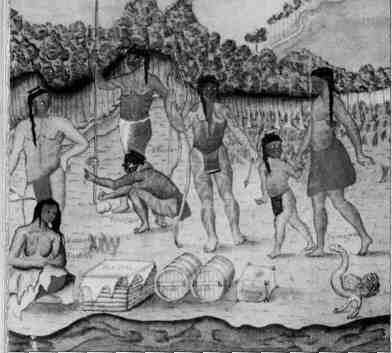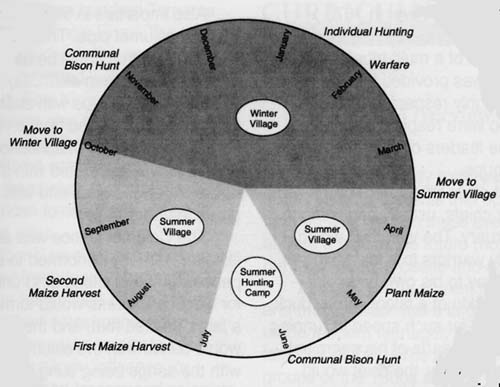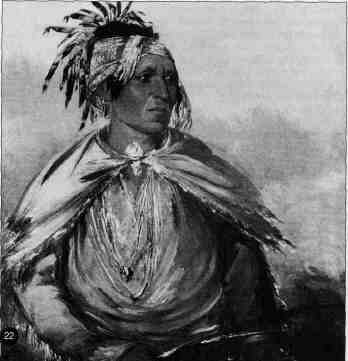 The Illinois Native Americans owned most of Illinois when the first French explorers and fur traders moved into the area. The Illinois were actually a confederation of tribes referred to as the Illiniwek or Illini. The tribes were the Kaskaskia, the Cahokia, the Peoria, the Tamaroa, Moingwena, Michigamea, Albiui, Amonokoa, Chepoussa, Chinkoa, Coiracoentanon, Espeminkia, Maroa, Matchinkoa, Michibousa, Negawichi, and Tapouara. Estimates of population range from a few thousand people to ten thousand people, so the State had a very low population.
The Illinois Native Americans owned most of Illinois when the first French explorers and fur traders moved into the area. The Illinois were actually a confederation of tribes referred to as the Illiniwek or Illini. The tribes were the Kaskaskia, the Cahokia, the Peoria, the Tamaroa, Moingwena, Michigamea, Albiui, Amonokoa, Chepoussa, Chinkoa, Coiracoentanon, Espeminkia, Maroa, Matchinkoa, Michibousa, Negawichi, and Tapouara. Estimates of population range from a few thousand people to ten thousand people, so the State had a very low population.The Illini were an Algonquian-speaking nation. What we know today about the Illinois is based on the historical account Jesuit Relations, written by French Jesuit priests.
Tribes were usually in a State of War with their neighboring tribes. And conflict with the French, British, and Americans added to the confusion.
When a Peoria warrior murdered the Ottawa war chief Pontiac in 1769, the northern tribes retaliated against the Illiniwek. They suffered more losses. Many of the Illinois migrated to present-day eastern Kansas to escape the pressure from other tribes and encroaching Europeans settlers.
There are many stories about the final defeat of the Illini. One story has it that they fought from near Chicago, fleeing the Iroqouis and their allies down Hickory Creek, the Desplaines River through Joliet and down to Starved Rock.
As a consequence of the Indian Removal Act, in the 1830s the Illinois were relocated from where they had migrated to eastern Kansas to northeastern Indian Territory. Today they chiefly reside in Ottawa County, Oklahoma, as the Peoria Tribe of Indians of Oklahoma.
____________________________
 Robert E. Warren Historical Research and Narrative
Robert E. Warren Historical Research and Narrative
In the summer of 1673, when Louis Jolliet and Jacques Marquette explored the Mississippi River, the Illinois Indian nation was one of the largest and most powerful ethnic groups in the American Midwest. The Illinois were composed of as many as twelve affiliated tribes and had a population of more than ten thousand people. Their territory, which the French called Le Pays des Illinois the Illinois Country encompassed one hundred thousand square miles of prairies, forests, and wetlands in the central Mississippi Valley. The Illinois were economically self-sufficient, supporting themselves with hunting, gathering, and agriculture. They also maintained trade relationships with distant Indian tribes and were embarking on a new political and economic alliance with French-Canadians that would last for five generations.
If we turn the calendar forward 159 years, to the summer of 1832, the scene is quite different. Most striking, perhaps, is that 98 percent of the Illinois Indian population has vanished. Warfare and disease have reduced the nation to two tribes totaling fewer than two hundred people. The Illinois no longer control the Illinois Country As their population declined, competing Indian tribes occupied much of their original territory. Now, all but a few square miles have been ceded by treaty to the United States government. The Illinois have become partially dependent on the government for economic support, receiving annual payments in compensation for their land. The political landscape has also changed. Euro-American claims to the Illinois Country have passed from France to Great Britain to the United States. In a matter of months, the last remnants of the Illinois Indians will abandon their homeland for a reservation in Indian Territory.
The story of the Illinois Indians is a remarkable tale of human endurance and survival. As a people, they overcame challenges that brought them perilously close to extinction. They also played key roles in the early history of Illinois as economic partners


Illinois Indians Visiting New Orleans, 1735 Detail of colored pen-and-ink drawing by Alexandre de Batz. Courtesy Peabody Museum, Harvard University. Photograph by Hillel Burger. ©Pres. and Fellows of Harvard College.
in the French fur trade, as military allies in the French and Indian War, as scouts and suppliers in the American Revolution, and as warriors who fought alongside United States troops in the Black Hawk War. They gave their name to the state of Illinois. And yet, their story has been minimized or ignored in general state histories, some of which are blatantly racist and ethnocentric. The Illinois Indians deserve a place in Illinois history.
At the time of contact, the Illinois or Illiniwek nation was a loose confederation of independent American Indian tribes who spoke a single Algonquian language (Miami-Illinois), had similar ways of life, and shared a large territory. The Illinois called themselves inoca. French explorers and missionaries generally referred to them as "Ilinois," but also used such terms as "Eriniouai," "Liniouek," and "Aliniouek." According to Marquette, Illinois meant "the men." However, a recent study of the Illinois language indicates the name may have instead come indirectly from the Illinois word irenwee-wa,which means "he speaks in the ordinary way."
In the late 1600s there may have been as many as twelve different tribes of Illinois Indians. By the end of the century, however, seven of these Chepoussa, Chinkoa, Coiracoentanon, Espeminkia, Maroa, Moingwena, and Tapouaro had disappeared or merged with other Illinois tribes. Five principal tribes survived into the eighteenth century: the Cahokia, Kaskaskia, Michigamea, Peoria, and Tamaroa. Only the Kaskaskia and Peoria continued to exist in the nineteenth century.
In the days of Jolliet and Marquette, Illinois territory consisted of a large triangular section of the central Mississippi River valley The Peoria, Moingwena, and several other tribes occupied the northwestern part of the region in what is now eastern Iowa. The Kaskaskia were settled to the northeast in the upper Illinois River valley. The Cahokia and Tamaroa occupied the central part of the region in western Illinois and eastern Missouri, while the Michigamea and Chepoussa lived in northeastern Arkansas. The Illinois' territory shrank dramatically during the 1700s and early 1800s as their population declined.
Much of what we know about traditional Illinois culture is based on French accounts written in the late 1600s by Marquette and a fur trader who lived among them named Pierre Delliette. Most available records pertain to the Peoria and Kaskaskia tribes; little is known about the Cahokia, Michigamea, and Tamaroa. Other information comes from archaeological excavations at Illinois village sites and from records maintained by the Illinois' living descendants.
The Illinois had a diverse economy based on agriculture, hunting, fishing, and the gathering of wild foods. Subsistence activities were divided based on gender; women were responsible for agriculture and gathering, while men did the hunting and fishing. Maize (corn) was the most important crop, but the Illinois also raised beans, squash, pumpkins, and watermelons. Women prepared their fields and began planting maize in early May. The first of two maize harvests came in late July, when ears were in the green stage. Green maize was usually preserved by scraping the tender kernals from the cobs using mussel shells, boiling them, and then spreading them out on reed mats to dry. The second harvest occurred in late August when the maize had ripened. Women stored vast quantities of dried maize in underground pits to be eaten during the lean winter months.
Hunting expeditions generally were undertaken by individuals or small groups. However, in June most people left the villages for communal bison hunts in the prairies. Upon finding a herd, runners would surround the bison on foot and firing their guns and arrows drive them toward the remainder of the hunting party where they were shot. After skinning and butchering the animals, women and girls would preserve the meat by placing it on wooden drying racks and heating it with small fires. Pierre
Delliette accompanied the Illinois on a communal hunt in the summer of 1688 that yielded more than twelve hundred bison, as well as bears, deer, elk, turkeys, bobcats, and mountain lions. In the fall, when prairie grasses were dry and flammable, the Illinois used fire as a bison-hunting strategy. Hunters would partially encircle a herd with a C-shaped ring of fire and station themselves at the opening where bison would attempt to escape the flames.
The Illinois occupied three types of settlements during the year. Summer villages, located near rivers, were inhabited during the planting season in April and May and again when the crops were harvested from mid-July to mid-October. The summer villages were semipermanent and quite large, some including as many as 350 mat-covered longhouses. The Illinois established summer hunting camps in the prairies during communal bison hunts. These camps were occupied briefly and consisted of temporary bark-covered lodges. After the fall harvest, residents of a summer village would divide into smaller groups and establish winter villages. These villages were located in river bottoms where good hunting was expected, often many miles away from the summer villages. Typically, each winter village contained five to twenty oval mat-covered lodges called wigwams.
Traditional Illinois technology included a variety of structures and objects that served their physical needs or had value in the society's economic, social, and belief systems. Prior to French contact, all technological materials were obtained by the Illinois from their natural environment or from Native American trading partners.
The largest of their residential structures was the longhouse. This was a long rectangular structure with a bent-pole framework that measured as much as fifty-eight feet long, twenty-four feet wide, and perhaps fifteen feet high. Walls and ceilings were covered with one or two layers of woven reed mats, which were waterproof and provided insulation. The interior was subdivided into separate living quarters for different families. Four or five hearths were placed down the midline of the structure, each fire serving the needs of two families. Wigwams were much smaller than longhouses and probably housed only one or two families.

Tools and utensils were made of wood, bone, horn, antler, shell, and stone. Wooden objects included serving platters, carved animal-effigy bowls, and handles for knives and other tools. A variety of objects were made of bison parts, including scoop-shaped horn ladles, bone hoes, bone arrow-shaft wrenches, and bone needles for weaving reed mats. Spears and arrows were tipped with cone-shaped antler points or triangular points made of chipped stone. Containers included shell-tempered clay pottery vessels and cloth bags made of spun bison hair.
Prior to the introduction of the horse in the early 1700s, the Illinois traveled either by walking or by floating in dugout canoes. Dugouts were made from the trunks of cottonwood trees, which were cut down and hollowed out using stone axes and controlled fires. According to Claude Dablon, a Jesuit priest, these dugouts were up to fifty feet long and three feet wide, and could carry thirty people with their baggage.
At the time Delliette lived among the Illinois, men married at about age twenty and women at eighteen. A man could initiate a marriage proposal by presenting gifts directly to his intended wife's brother, or by urging his father to present gifts to her family. Lacking any objections by the girl or her brother, the woman's family would accept the gifts and escort her, adorned with "glass beads, porcelain, and bells," to the man's lodge. After a series of visits and gift exchanges among the families lasting up to four days, the bride would remain in the lodge of her husband. Successful hunters often had more than one wife, usually including the wife's sisters, aunts, or nieces.
Marquette and Jolliet met the "great Captain," or chief, of the Peoria Tribe at his
village on the Des Moines River in 1673. At that time, each tribe evidently had its own village or its own part of a multi-tribal village. Political leadership was provided by peace chiefs, who were highly respected by tribal members and who were responsible for interacting with the leaders or representatives of other ethnic groups.
Raids against other tribes were organized by successful war chiefs, usually beginning in the month of February. The war chief would invite about twenty warriors to a feast, where each man would pray to his own bird spirit-represented by the skin of a falcon, crow, duck, parrot, or other bird for such speed in running as to strike fear in the hearts of his enemies. After closing on the enemy, the chief would offer a prayer to the warriors' birds, which he carried with him, and each man would attack voicing the cry of his bird. Capturing prisoners was more highly esteemed than killing enemies. Some prisoners were killed; others were adopted or kept as slaves.
The Illinois worshiped one preeminent deity (Kitchesmanetoa) above all others, which they considered the maker of all things. They also honored the sun and thunder, deities of the Upper World that maintained life and the earth's fertility. Shamans men or women with supernatural healing powers appealed to animal spirits for knowledge of special medicines and healing rituals.

Man Who Tracks (Pah-me-cow-ee-tah), a Peoria Illinois Chief, 1830.
Oil on canvas by George Catlin in the Fort Leavenworth area. Courtesy of Smithsonian
American Art Museum, Washington, D.C. Gift of Mrs. Joseph Harrison, Jr.r Kids: Illinois Indians (Illini) - Orrin's Website
Illinois Confederation - Wikipedia, the free encyclopedia
The Illinois Confederation, sometimes referred to as the Illiniwek or Illini, were a ... in Ottawa County, Oklahoma, as the Peoria Tribe of Indians of Oklahoma.
Images for illini indians
- Report imagesNative Americans: Illini History and Culture (Illinois Indian Tribe ...
www.native-languages.org › ... › What's newLanguage, culture, history and genealogy of the Illini or Illinois Indians.What is the religion o the illini tribe in illinois? - Yahoo! Answers
answers.yahoo.com › ... › Religion & Spirituality3 answers - Oct 13, 2010Top answer: As the unofficial "World's Biggest Illini Fan" I have studied this to some extent, and although Aonghas is correct, they have ommitted a key fact that the ...The Illiniwek & Shawnee of Southern Illinois - Museum homepage
www.schools.lth5.k12.il.us/bths-east/illiniwek.htmlShare"The Illinois Indians, also known as Illini or the Illiniwek, were a group of independent tribes sharing a common language and a common origin. The Illinois ...
